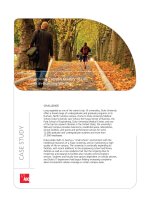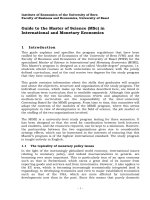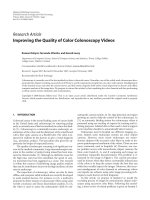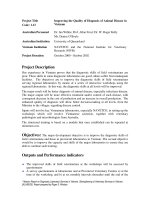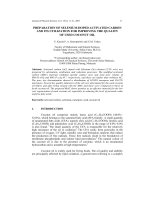Consultee-Centered Consultation Improving the Quality of Professional Services in Schools and Community Organisations ppt
Bạn đang xem bản rút gọn của tài liệu. Xem và tải ngay bản đầy đủ của tài liệu tại đây (19.16 MB, 414 trang )
Consultee-Centered
Consultation
Improving
the
Quality
of
Professional
Services
in
Schools
and
Community
Organisations
The
Consultation
and
Intervention Series
in
School Psychology
Sylvia
A.
Rosenfield,
Series
Editor
Lambert/Hylander/Sandoval
•
Consultee-Centered Consultation:
Improving
the
Quality
of
Professional
Services
in
Schools
and
Community
Organizations
Consultee-Centered
Consultation
Improving
the
Quality
of
Professional
Services
in
Schools
and
Community
Organizations
Edited
by
Nadine
M.
Lambert
University
of
California
at
Berkeley
Ingrid
Hylander
University ofLinkoping, Sweden
Jonathan
H.
Sandoval
University
of
California
at
Davis
LAWRENCE ERLBAUM
ASSOCIATES,
PUBLISHERS
2004
Mahwah,
New
Jersey London
Copyright
©
2004
by
Lawrence
Erlbaum
Associates, Inc.
All
rights
reserved.
No
part
of
this book
may be
reproduced
in any
form,
by
photostat,
microform, retrieval system,
or any
other
means,
without
prior
written permission
of the
publisher.
Lawrence Erlbaum Associates, Inc., Publishers
10
Industrial Avenue
Mahwah,
New
Jersey
07430
|
Cover design
by
Kathryn Houghtaling Lacey
Library
of
Congress
Cataloging-in-Publication
Data
Consultee-centered consultation
:
improving
the
quality
of
professional
services
in
schools
and
community organizations
/
edited
by
Nadine
M.
Lambert, Ingrid Hylander, Jonathan
H.
Sandoval
p. cm.
Includes
bibliographical references
and
index.
ISBN
0-8058-4463-5
(alk. Paper)
1.
Educational counseling.
2.
Counselors—Professional relationships.
I.
Lambert,
Nadine
M. II.
Hylander, Ingrid. III. Sandoval, Jonathan.
LB1027.5.C622152003
371.4—dc22
Books
published
by
Lawrence Erlbaum
Associates
are
printed
on
acid-free
paper,
and
their bindings
are
chosen
for
strength
and
durability
1
.
Printed
in the
United States
of
America
10
987654321
Contents
Part
I
Theoretical Advances
in
Consultee'Centered Consultation
These
papers
provide
a
history
of
consultee-
centered
consultation
as a
method
for
promoting
the
well-being
of
the
population,
and
show
how the
method
has
evolved
over
the
years
to
become
an
approach with broad
applications
serving
professionals
and
their clients
in
school
and
community settings.
1
Consultee-Centered Consultation:
An
international
3
Perspective
on
Goals, Process,
and
Theory
Nadine
M.
Lambert
2
Recent Advances
in
Mental Health Consultation
21
and
Collaboration
Gerald Caplan
3
Constructivism, Consultee-Centered Consultation,
37
and
Conceptual Change
Jonathan
Sandoval
4
Analysis
of
Conceptual Change
in
Consultee-Centered
45
Consultation
Ingrid
Hylander
Part
II
Consultee'Centered Consultation With Schools
and
Community Organizations
This part
is
divided into sections
focused
on the
following
settings:
Preschool
and
Child
Corel, School, Health
and
Welfare,
Corporate settings,
and
Evaluation
Practice.
In
each
of the
sections,
the
authors
address
the
following:
A. the key
factors that support
the
consultation
process including.:
the
general
structure
of
the
organization;
the
culture
of
the
organization;
how
consultation
is
initiated; entry approaches into
the
organization
and the
individuals responsible
for the
consultation
agreement; clients
of
the
orga-
v
vi
CONTENTS
nization;
specific
features
and
description
of the
consultation process
n
the
particular system; evaluation
of
consultation
in
ongoing
or
short-term
relationships;
B.
ways that
the
interaction between consultant
and
consultee
pro-
mote conceptual change
as
evidenced
by:
changes
in the
ways that
the
problem
is
presented
by the
consultee
and
consultant;
and,
changes
in the
ways
that
the
problem
is
represented
or
understood
by the
consultant
and
the
consultee.
Preschool
and
Child Care
5 A
Model
for
Consultation With
Day
Care
and
Pre-Schools
65
Ingrid
Hylander
and
Gunilla Guvd
School
6
School Psychologists
as
Consultee-Centered Consultants
79
Within
a
System-of-Care Framework:
Service
and
Training Challenges
Brent
Duncan
7
Facilitating Conceptual Change
in New
Teacher
101
Consultation
Groups
Leslie
Babinski, Steven Knotek
&
Dwight
L.
Rogers
8
Alternative School Psychological Services: Development
115
of
a
Model Linking Theory, Research,
and
Service Delivery
Chr^se Hatzichristou
9
Multicultural
Consultee-Centered Consultation:
135
Supporting
Consultees
in the
Development
of
Cultural Competence
Colette Ingraham
Health
and
Welfare
10
Thirty
Years
of
Consultation
to
Child
Welfare
151
Paul
Steinhauer
11
Consultee-Centered Consultation
in a
Network
173
Intervention With Health Providers
Jose
Navarre Gongora
CONTENTS
vii
12
Consultee-Centered Consultation
in Low
Feasibility
189
Settings
Ruth
B.
Caplan-Moskovich
and
Gerald
Caplan
13
Consultation
and
Administrative Coordination
205
in a
Special
Day
Treatment Setting
Eva
Rubin
and
Marjatta
Eladhari
Corporate Settings
14 The
Consultation Process
in
Corporate Groups
223
Margit
Ekenbark
Evaluation Practice
15 The
Legacy
of
Consultee-Centered Consultation
235
for
Collaborative Research
James
G.
Kelly
Part
III The
Consultation Process
-
Dialogues Across
Settings
and
Disciplines
to
Activate Conceptual Change
The
chapters
in
this
section
describe
techniques
and
processes
involved
in
consultee-centered
consultation
that
promote
engagement
in the
process
and
new
conceptualizations
in
both
the
presentation
and
representation
of the
professional
problem.
16
Complicating
the
Thinking
of the
Consultee
249
Eva
Marion
Johannessen
17
Meeting
a
Teacher
Who
Asks
for
Help,
But Not for 257
Consultation
Gunilla
Guvd
18
What
Does
He
Look
Like?
From
the
Inner World
of the 267
Consultee
to the
Inner World
of the
Client
Marianne
Brodin
19
Allowing Ambiguity
and
Listening
to the
Contradictions
281
Solveigh
Thorn
viii
CONTENTS
20
Anger
and
Gender
in
Consultation
293
Elin
Michelsen
21
Using Metaphors,
Parables
and
Anecdotes
in
Consultation.
303
Michelle
Mang
22
Promoting Student Learning
by
Consultee-Centered
315
Consultation.
Petri
Partanen
&
Carl
Wistrom
23 To
"Create
a
Conversation
That
is a
Little
Bit
Different"
325
Anders
Wddchter
24
Consultation
as
Dialogue:
The
Right
Words
339
at
the
Right Time
Sylvia
Rosenfield
25
Developing Through Discourse: Speech Genres
as
Pathways
351
to
Conceptual Change
Steve
Knotek
26
Reflectivity
in
Consultation
361
Margaret
Garcia
Part
IV
Evidence
of the
Impact
of
Consultee-Centered
Consultation
Models
for
evaluating
change
in the
consultation
process
focus
on the
interplay
between
the
consultants'
and
consultees
presentations
of the
problems
and
representations
of its
underlying
dynamics.
Documenting
the
impact
of
con-
sultation
involves
assessing
the
conceptual
development
that
occurs
for the two
or
more
participants
in the
process
and the
effects
of
this
change
on the
clients.
27
Identifying
Change
in
Consultee-Centered Consultation
375
Ingrid
Hylander
28
Evaluation Issues
and
Strategies
in
Consultee-Centered
393
Consultation
Jonathan
Sandoval
Index
401
I
Theoretical
Advances
in
Consultee-Centered
Consultation
These
papers provide
a
history
of
consul
tee-centered
consultation
as a
method
for
promoting
the
well-being
of the
population,
and
show
how the
method
has
evolved over
the
years
to
become
an
approach with broad applications serving
professionals
and
their clients
in
school
and
community settings.
This page intentionally left blank
1
Consultee-
Centered
Consultation:
An
International
Perspective
on
Goals,
Process,
and
Theory
Nadine
M.
Lambert
University
of
California
at
Berkeley
CONSULTEE-CENTERED
CONSULTATION
IN
SCHOOLS
AND
COMMUNITY MENTAL HEALTH PROGRAMS:
HISTORICAL FOUNDATIONS
Consultee-centered
consultation
in the
21st
century
has its
origins
in the
con-
sultation
methods introduced
in the
late 1950s
and
early 1960s. Mental health
specialists
were grappling with
ways
to
broaden
the
application
of
mental health
principles
in
community settings
to
reduce
the
prevalence
of
mental health dis-
orders,
and to
develop strategies
to
intervene with
the
mental health, learning,
and
behavioral problems
of the
general
population.
These
efforts
to
design
federal,
state,
and
local mental health services with
a
broader
out-reach culminated
in the
Federal
Community
Mental Health Cen-
ters
Act
(U.S. Public
Health
Service, 1963)
followed
by
similar state legislative
mandates.
These
legislative initiatives outlined
a
wide range
of
interventions
by
mental health specialists
from
consultation
to
hospitalization.
The new
models
for
comprehensive community mental health services envisioned
a
cadre
of
4
LAMBERT
mental health
professionals
who
would
be
available
to
offer
mental health edu-
cation, consultation
to
care
giving
professionals,
brief mental health interven-
tions, psychotherapy,
and
intensive long term psychological services depending
on the
setting
and the
presenting problems.
These
federal
and
state
programs
gave
an
impetus
to the
development
of
consultee-centered mental health
con-
sultation.
(Caplan,
G.,
1956, 1963, 1970, 1980;
Caplan,
R.B. 1993;
Caplan
&
Caplan,
1993)
as an
essential mental health service
to
schools, professional
or-
ganizations,
and
community agencies.
The
term mental health
in
consultee-centered consultation
reflected
the
fact
that
the
foundations
of
consultee-centered consultation were
focused
on
ser-
vices
that were:
1.
related
to
mental health disorder
or
personality idiosyncrasies
of the
client
2.
promotion
of
mental health
in the
client,
or
3.
interpersonal aspects
of the
clients work situation (Caplan,
1970,
p.
28-30).
As the
method outlined
by
Caplan evolved over
the
intervening years,
the
work
problems
of the
clients consultees sought help with, broadened
to
include,
for
example, child development issues, motivation, learning
and
behavior prob-
lems
in
schools,
family
disruption
and
conflict,
and
organizational
and
system
concerns,
not all of
which could
be
considered
as
"mental health" problems,
even
though they might involve mental health components.
This
volume reflects
the
advances
in the
method
by
mental health
profes-
sionals
in
many
countries,
offers
a
contemporary
definition
of
consultee-cen-
tered consultation, provides examples
of the
ways
it can be
used
in
serving
clients with varying presenting problems
in
diverse settings,
and
presents some
techniques that have proved valuable
in
enhancing
the
problem-solving
reper-
toires
of
consultant
and
consultee professionals.
The
underlying theme
of
these
presentations
is the
focus
on the
process
of
consultee-centered consultation
and
its
goal
of
promoting conceptual change
in
both
the
consultee
and the
consul-
tant
as
they jointly develop strategies
for
solving
the
consultee's
work problem.
CONSULTEE-CENTERED CONSULTATION
All
professional consultation involves
a
consultant,
consultee,
and a
client,
cli-
ents,
or an
organization,
and
takes into account
the
ecological
or
organizational
system
in
which
the
presenting problem
is
discussed.
It is
important
at the
out-
set
to
distinguish between consultee-centered consultation
and
client-cen-
1.
AN
INTERNATIONA!.
PERSPECTIVE
5
tered
consultation
as
both methods involve consultants, consultees,
and
clients.
Traditional
or
client-centered consultation takes place when
a
consultee seeks information
or
confirmation
or
advice
from
a
consultant about
a
work problem regarding
a
client.
The
consultation process could involve dis-
cussions
about assessment
results,
case
findings,
diagnoses,
or
recommenda-
tions
for
interventions.
This
type
of
consultation
can
include consultee requests
for
more diagnostic information about
the
presenting
problems, advice about
whether
the
services provided
are
appropriate, recommendations
for
practice,
and
clarification
of
facets
of the
client's problem that
the
consultant
profes-
sional
is in a
position
to
answer.
The
consultant
who
accepts
the
request
to
provide
client-centered
consulta-
tion acknowledges that
his or her
expertise
is
appropriate
to
evaluate
the
cli-
ent's problem
and to
offer
an
expert perspective
and
recommendations
to the
consultee-professional.
Client-centered
consultation
is
hierarchical
and
pre-
scriptive.
The
consultant
is the
expert
who
offers
his or her
opinion
and
makes
recommendations
for
follow-up
action. Although
the
consultant
may not
nec-
essarily
see the
client
in
client-centered
consultation—such
as in
cases where
the
consultant reviews
a
case
file
or
diagnostic findings with
the
consultee—the
relationship remains hierarchical,
and the
recommendations
or
"prescriptions"
follow
from
the
consultant's background
and
expertise.
Caplan (1970) outlined several characteristics that
differentiated
consultee-
centered mental health case,
program,
or
administrative consultation
from
cli-
ent-centered consultation.
All
of
these remain characteristic
of
consultee-centered
consultation.
The
consultant
has no
administrative responsibility
for the
consultee's
work,
and no
professional responsibility
for the
outcome
of the
client's
case.
The
consultant
is
under
no
obligation
to
modify
the
consultee's behavior
to-
ward
the
client. Similarly,
the
consultee
has no
compulsion
to
accept
the
consul-
tant's ideas
or
suggestions.
There
is a
coordinate relationship between
the
consultant
and
consultee
and an
understanding that together they
will
discuss
the
work
problem sharing respective
views
of the
problem
from
their
own
perspectives.
The
discussion about
the
client occurs among
two
professional
equals.
This
coordi-
nate relationship
is
fostered
by the
consultant being
a
member
of
another
profes-
sion.
The
consultant
has no
predetermined body
of
information that
is to be
imparted
to the
consultee. Although there
is no
predetermined body
of
knowledge
to be
imparted,
the
consultant
has a
wide range
of
professional experience
and
knowledge,
and an
array
of
theories that could
be
useful
in
assisting consultee
to re-
solve
the
work problem,
if
he or she
decides that
it is
relevant
and
wants
to use it. A
consultee asks
for
consultation
from
someone that
he or she
trusts
and from one
who
has
professional experience
and
knowledge
in
another
field.
6
LAMBERT
The
consultant acknowledges that
the
consultee
has
relevant expertise about
the
client's work problem
and
aims
to
elicit
this
knowledge
in the
consultation
process.
The
consultant hopes
to
help
the
consultee improve
the
handling
or un-
derstanding
of the
current work problem with
the
goal
of
assisting
the
consultee
to
manage
similar
problems
in the
future.
The aim is to
effect
changes
in the
consultee's
performance
and not his or her
sense
of
well-being.
Consultee-cen-
tered consultation does
not
involve
the
discussion
of
personal
or
private material,
and the
consultation process
is
understood
to be a
privileged communication.
The
responsibility
for the
outcome remains with
the
consultee.
CALIFORNIA
INITIATIVES SUPPORTING
CONSULTEE-CENTERED
CONSULTATION
IN
SCHOOLS
At the
time
of the
development
and
implementation
of
comprehensive
com-
munity mental health programs,
the
California State Legislature (Joint Interim
Committee
on
Education
and
Rehabilitation
of
Handicapped Children,
1959)
authorized
a
major
research program
in
1958
to
study
and
recommend methods
for
identification
and
education
of
children
who
were described
as
"emotionally
disturbed," (later changed
to
"emotionally
handicapped.")
These
were children
with
serious learning
and
behavior problems whose teachers
found
it
difficult
to
manage
in the
regular classroom situation.
It was
generally recognized that
there
was a
range
of
severity
of
such problems among
school
children, supported
by
state estimates
of
their prevalence
by
State Department
of
Education
re-
search
staff
(Bower,
1958, 1959-1960).
The
research program undertook
the
establishment
and
evaluation
of the
merits
of an
array
of
services reflecting
the
seriousness
of the
child's problems,
from
help
to the
teacher when
a
child could
remain
in the
classroom,
to
learning disability groups
for
children whose
pri-
mary
problems were basic
skill
acquisition,
to all day
special classes
for
those
whose
needs
were more
intense
and
involved,
and to
home
and
hospital
in-
struction
for
children
who
could
not
attend
school.
As
model programs were
be-
ing
established
in
many
school
districts
in
California,
the
Federal
Government
was
receiving testimony
on the
mental health needs
of
children
from
a
National
perspective. Many mental health
and
education
professionals
proposed strate-
gies
for
reducing
the
prevalence
of
these
problems
and
were active
in the
discus-
sions
about
the
roles
of the
schools
and
teachers
in
meeting
the
needs
of
emotionally handicapped children.
It
was
inevitable that
the
research
team
directing
the
California research
on
programs
for
emotionally handicapped children would
become
involved
in the
community mental health movement
and its
leaders, among whom were Gerald
Caplan,
borrowing
from
their experience
those
programs that might
be
adopted
1.
AN
INTERNATIONAL
PERSPECTIVE
7
in
the
school setting.
So, as
directors
of
community mental health centers con-
templated
training
for and
programming
the new
models
of
mental health ser-
vices,
one of the
promising directions they promoted
was the
adoption
of
consultee-centered
mental
health
consultation,
principally
as
described
by
Caplan (1956, 1963).
The
California research team included "consultation
to
teachers"
as one of the
programs
to be
implemented
and
evaluated.
For the re-
search
effort
mental health professionals
from
the
community were employed
to
provide
consultee-centered mental health consultation
to
teachers
in the
school district research sites. Some
of the
consultants
had
studied with Caplan
at
Harvard.
In
order
to be
sure that those providing consultation were cognizant
of
the
objectives
of
consultee-centered mental health consultation
and
were
conforming
to the
principles that
had
been laid out,
a
training consultant grad-
uate
of the
Harvard program
in
Community Psychiatry
was
brought
on
board
to
guide
the
efforts
of the
consultants
who
were assigned
to the
teacher consultees.
It
was the
responsibility
of the
research
staff
to
negotiate with
the
school dis-
tricts
the
actual contracts
for the
services
that
would
be
provided including
the
consultant's weekly meetings with teachers,
the
monthly meetings with
the
site
administrator,
and
ways
of
resolving
any
problems
that
might arise.
The
recommendations
of the
research team (California State Department
of
Education, 1961) were reported
to the
Legislature
in
1961, ultimately
to be
adopted during
the
1963 session
of the
Legislature. "Emotionally handicapped"
was
changed
to
"educationally handicapped"
and
services were authorized
for
reimbursement
ranging
from
consultation
to
teachers
to
home
and
hospital
in-
struction, depending
on the
nature
and
severity
of the
presenting problems
of
the
child. Methods
for
identifying
children
in
need
of
services were also made
available
(Bower, 1960; Lambert, Bower,
&Hartsough,
1961,1974,
1979),
and
publications pursued
the
role
of
education
as an
agent
in the
prevention
of
men-
tal
disorders among children. (Bower, 1961, 1965; Bower, Shellhammer,
&
Daily,
1960; Lambert, 1961, 1965.)
The
legislation
for
educationally handicapped children
did not
restrict
the
consultation services
to
those provided
by a
mental health professional
from the
community,
but
facilitated
the
expansion
of the
role
of
school psychologists
to
include consultation
to
teachers
as a
strategy
for
discussions about problems
with
students without having
to
rely
on the
results
of
test administrations
and
diagnostic services. However, providing consultee-centered consultation
re-
quired training, whether
the
consultant
was an
experienced mental
health
pro-
fessional
or a
school psychologist.
The
outcome
of
these early
efforts
to
implement consultation programs
consistent
with
the
provisions
of the
Com-
prehensive Community Mental
Health
Services
Act of
1963,
or the
California
8
I.AMBERT
State Department
of
Education legislation
for
educationally
handicapped chil-
dren
in
1963 should
be
interpreted with respect
to the
extent
to
which those
who
provided consultation received
any
training
in
this
new
method.
CONSULTEE-CENTERED
CONSULTATION
IN
SCHOOLS
In
my
presidential address
to the
California
Association
of
School Psychologists
(CASP)
in
1963,1
detailed
a
vision
of
school psychology with
a
primary
mission
of
the
promotion
of the
personal, social,
and
academic development
of
chil-
dren,
and the
prevention
of
school
failure.
School
psychologists,
in my
vision,
would
gradually
become more visible
on
school sites,
by
moving
out of
their
of-
fices
administering tests
and
meeting
with parents
to
obtain consent
for
special
education placement,
to
meeting with teachers
to
plan
for a
systematic assess-
ment
of
children's needs
and
follow-up
consultee-centered
consultation.
In
1962 when
I was
responsible
for the
program
for the
annual
convention,
I in-
vited
experts
to
show
how
learning
how to
read could promote mental health,
how
consultee-centered
consultation
would broaden
the
service delivery
op-
tions
for
school psychologists
to
assist teachers
to be
cognizant
of and
more
re-
sponsive
to the
needs
of
children
with problems,
how
education
had
preventive
power,
and
examples
of
primary
and
secondary prevention
efforts
already
un-
derway
in
various school settings.
Those
presentations became
a
U.S. Public
Health Service Monograph (Lambert, 1965)
on the
"Protection
and
Promotion
of
the
Mental Health
of
Children."
Now
that
consultee-centered
consultation
had
shown
its
value when pro-
vided
by
community-based consultants
and was
sanctioned
by the
State Legis-
lature
for
school psychological service delivery systems,
the
task ahead
was to
inform
educational professionals
and
school
psychologists
of the
preventive
agency
for
consultee-centered consultation,
and to
develop programs
to
train
those
who
would provide such services.
At the time
these important national
and
local initiatives were underway, those
who
provided consultee-centered
mental health consultation received their consultation training
after
prepara-
tion
in
their specialty.
The
issue
of
whether
consultation
training could become
part
of the
preparation
of the
school
psychologist
as he or she was
learning
the
specialty
was
debated.
When
I
went
to
Berkeley
in
1964
to
develop
a
doctoral level school psychology
program,
I
pursued
the
challenge
I
laid down
as
president
of
CASR
the
Berkeley
program
would provide consultation training (Lambert, 1974, 1986) along with
preparation
for
other
school
psychological services.
Issues
pertaining
to the
nov-
ice
consultants having
to
learn consultation
skills
along with other professional
1.
AN
INTERNATIONA!.
PERSPECTIVE
9
services
would have
to be
resolved with experience.
We
provided
a
training
con-
sultant
for
students during their year-long service
to
teachers
as
well
as a
training
supervisor
who
monitored both
the
process
of
acquiring
consultation
skills
as
well
as
the
professional
standards students were
to
demonstrate
in
their school place-
ments (Lambert, Sandoval,
&Yandell,
1975),
and we
evaluated
the
services that
the
student consultants were
offering
to the
teachers (Lambert, Sandoval,
&
Corder,
1975; Sandoval
&
Lambert, 1987.)
Once
the
structure
for the
training
was
set up
(Lambert,
1983),
we
focused
our
energies
on the
critical challenge
of
examining
more closely
the
process
of our
consultation
efforts,
and the
contrasts
between services
offered
by
community-based consultants,
and
those provided
by
consultants
who
were school-based.
Several
issues
facing
the
school-based
consul
tee-centered
consultant
had to
be
addressed squarely. Among these were redefining
a
request
for
diagnostic
services
to a
request
for
consultation
before
services were
to be
provided.
In
those cases where
the
school-based consultant
was
seeing only
the
teacher
and
not the
student,
the
school-based consultant
had to be
cautious about
the
effort
being
seen
as one
where
the
teacher
was
being evaluated, diagnosed,
or
treated
rather
than
one of
egalitarian information-sharing
and
joint problem solving
about
the
student.
Still
another issue
was the
extent
to
which
the
consultant
had an
agenda
for
the
consultation,
or the
teacher
had an
agenda.
The
consultant's agenda
might
be to
correct
a
teacher's
way of
managing
the
classroom,
or the
teacher-consultee might expect
that
the
meeting would result
in
moving
the
child
to
another classroom
or to
special education
or to get
counseling ser-
vices.
And
finally,
the
matter
of
responsibility
for
follow-up action
was ex-
pected
to be
more
difficult
for the
school-based consultant whose salary
was
being paid
from
the
same
source,'and
who
might have problems
not
being
in
some
way
responsible
for the
well-being
of the
students.
But
although these
issues
were critical
to the
clarity with which
the
school-based consultant
learned
and
practiced consultation skills,
it
became apparent that
it was not
these parameters that were
the
most important facets
of the
successful
school-based
consultation
effort,
but
rather
the
process that
was
taking
place.
We
observed
that
the
student consultees could become proficient
at
providing
consultation services, ameliorating
our
concern
that
they would
have
to be
fully
trained professionals before consultation training. They
be-
came informed
and
knowledgeable about teacher perspectives,
issues
in
teaching, ways that teachers reacted
to
particular types
of
student problems,
the
challenges that were
difficult
for all
teachers
in
contrast
to
idiosyncratic
matters
affecting
only
one
teacher.
10
LAMBERT
As we
were gaining experience
in our
consultee-centered
consultation train-
ing
efforts,
others were promoting
new
approaches
to
consultation. Many
of
these approaches
reflected
the
"adjective"
in
front
of
consultee-centered
con-
sultation.
Consultee-centered
mental health consultation
was
concerned with
consultee work problems
of a
mental health nature invoking
the
consultant's
psychodynamic
theoretical
framework
(James,
Kidder,
Osberg,
&
Hunter,
1986).
Behavioral consultation, while centering
on the
teacher,
was
also
an ef-
fort
to
bring
a
particular theoretical perspective
to the
consultation process
and
aimed
to
shed light
on
student behavior problems
by
assisting teachers
to de-
velop
a
more
effective
management programs
to
improve student behavior
in
the
classroom
(Keys,
1986).
Organizational consultation focused
on
organiza-
tional development
and
systems theory
(Vernberg
&
Repucci, 1986)
and
viewed
presenting problems
as
reflecting larger problems within
the
school
or
district.
The
espoused
theories
of the
consultant began
to
drive
the
consulta-
tion process
Qames,
Kidder,
Osberg,
&
Hunter, 1986;
Mannino,
Trickett,
Shore,
Kidder,
&
Levin,
1986).
For us at
Berkeley,
it was
obvious that
no
single
theory
was
sufficient
to
respond
to the
many
and
complex work problems
the
teachers encountered.
And
students, like their professors, were
not
omniscient.
But
consultants needed
a
broad theoretical perspective,
and
could
not
rely
on
any
single theoretical model
if
they were
to be
responsive
to the
teacher's con-
cerns with students.
These
early descriptions
of the
consultee-centered
consultation method
were focused
on the
parameters
of
consultation—such
as
inside
or
outside con-
sultants,
responsible
for
action versus
not
responsible
for
action, teacher
re-
quests
for
help versus psychologist suggestions
for
consultation,
and the
role
of
the
consultant with respect
to
teacher evaluations.
And
foremost among these
distinctions
was
whether
the
consultation
was
hierarchical
or
nonhierarchical
and
prescriptive versus
not
prescriptive.
At the
core
of
consultee-centered
con-
sultation
as it
evolved
at
Berkeley,
and as it has
been
developed
by
Caplan
are
that
it is a
nonhierarchical
nonprescriptive process
and it
requires
more
than
one
theoretical perspective.
CONCURRENT
INTERNATIONAL
PERSPECTIVES
ON
CONSULTEE-CENTERED
CONSULTATION
Whereas
those
of us in the
United States were
concerned
with models, training,
and
evaluation
for
consultation services, mental health professionals
in
other
countries were having similar experiences
and
developing comparable models
to
what
we
were trying.
On
October
17,
1989,
three psychologists
from
Sweden
who
were
in
Berkeley
to see the
late Millie
Almy,
a
professor
in
early
childhood
I.
AN
INTERNATIONAL
PERSPECTIVE
11
education,
came
to see us at the
suggestion
of Eva
Johannssen
from
Norway,
who had
spent some time earlier
at
Berkeley studying consultation.
We
dis-
cussed
the
consultation programs that they were
offering
and
suggested that
they
share their experiences with
our
students
at a
program meeting.
When
they
described their consultation services
to
Swedish child-care programs,
the
problems
and
challenges that they experienced,
and the
strategies
for
consulta-
tion
that they
had
developed,
it was as if
they
had
been
in
Berkeley working
in
the
same school sites,
not
thousands
of
miles
away
in
Sweden. Shortly
after,
Ing-
rid
Hylander, Jonathan Sandoval,
and I
placed
in
motion
the
establishment
of
an
International Seminar
on
Consultee-Centered Consultation.
At a
first
meeting
we
would invite
all of
those using
consultee-centered
consultation
methods, which
we
could
identify
from
personal knowledge
or
their writings,
to
attend
to
share experiences,
and to
establish
a
common ground
for
defining
the
current status
of the
consultee-centered consultation
method.
The
initial
meeting
was
held
in
Stockholm, Sweden
in
1995,
a
second
one in
Stockholm
in
1999,
and a
third
in San
Francisco, California
in
2001.
What
seemed obvious
on
that
day in
October
1989—the
day of the San
Francisco Loma Prieta earth-
quake—was
that
a
focus
on the
processes
of
consultee-centered
consultation,
processes,
rather than parameters, would
be
necessary
to
describe conceptual
changes
in the
consultee
as
well
as in the
consultant. Consultation processes
would
be the
defining principles distinguishing
consultee-centered
consulta-
tion
from
other consultation methods.
Definition
of
Consultee-Centered
Consultation—
A
Consensus
From
the
Seminar
Participants
At
each meeting
of the
Seminar
on
Consultee-centered consultation there
were
discussions about
the
need
for a
definition that would capture
the
diversity
of
consultee-centered
consultation
efforts
that were taking place,
but one
with
elements common
to all
consultee-centered consultation,
and a
definition that
would
emphasize process
and
conceptual change.
The
result
the
following:
Consultee-centered
consultation
emphasizes
a
nonhierarchical, nonprescriptive help-
ing
role relationship between
a
resource (consultant)
and a
person
or
group (consultee)
who
seeks professional help with
a
work problem involving
a
third party
(client).
This
work problem
is a
topic
of
concern
for the
consultee
who has a
direct responsibil-
ity
for the
learning, development,
or
productivity
of the
client.
The
primary task
of
both
the
consultant
and the
consultee
is to
choose
and
reframe
knowledge about well-being, development, intrapersonal, interpersonal
and
organiza-
tional
effectiveness appropriate
to the
consultee's
work setting.
12
LAMBERT
The
goal
of the
consultation process
is the
joint development
of a new way of
con-
ceptualizing
the
work problem
so
that
the
repertoire
of the
consultee
is
expanded
and the
professional relationship between
the
consultee
and the
client
is
restored
or
improved.
The
chapters
in
this volume
illustrate
consultation practice that
reflects
this
definition
in a
diversity
of
settings
with
varying organizational goals,
and
with
consultants
and
consultees with
differing
professional responsibilities.
CONCEPTS, PRINCIPLES,
AND
PRACTICE
OF
CONSULTEE-CENTERED
CONSULTATION
Client-centered
consultation, that type
of
exchange that takes place when
a
professional
seeks information
or
confirmation
from a
specialist,
is
clearly
fo-
cused
on
case
findings
about
the
client.
These
findings
can
include more
infor-
mation about
the
presenting problems, advice about whether
the
services
provided
are
appropriate,
or
clarification
of
facets
of the
client's problem that
the
professional
is not in a
position
to
uncover.
And
usually
in
this type
of
con-
sultation,
the
consultant
who
accepts
the
request
to
provide information
has
agreed
that
his or her
expertise
is
appropriate
to the
request
to see or
evaluate
the
client's
problem
and to
offer
an
evaluation
of the
problem along with recom-
mendations
to the
consultee
professional.
However,
the
process changes when
the
focus
of the
consultation
shifts
to
the
consultee
in an
effort
to
assist
the
consultee with
a
work problem
and the
consultant
is not
expected
to see the
clients
directly.
The
consultant's
focus
on
the
consultee
can be
seen
by the
novice consultant
as an
invitation
to
assist
the
consultee
with
the
consultee's problems rather that
to
assist
the
consultee with
the
development
of
alternatives
to
help
the
client.
Or the
novice consultant
who has
developed diagnostic
and
intervention theories
may see the
consultee
as
the
consultant's agent
in
serving client needs
as
perceived
by the
consultant
within
his
particular theoretical
framework.
The
shift
from
the
consultant's
focus
on the
client with assessments, diag-
noses,
and
recommendations
for
plans
of
action,
to a
focus
on the
consultee's
presentation
of the
client's
problems
is a
major
shift
in the
roles
of
the
consultant
and
consultee.
The
process
of
discussion also
differs
sub-
stantially
between client-centered
and
consultee-centered consultation
from
hierarchical
and
prescriptive
to
nonhierarchical
and
nonprescriptive.
Consultee-centered consultation
is
nonhierarchical because
both
the
con-
sultant
and the
consultee
are
considered
to
have expert knowledge about
1.
AN
INTERNATIONA!.
PERSPECTIVE
13
the
problem, shared knowledge
that
is
highlighted
in the
problem solving
process.
Consultee-centered
consultation
is not
prescriptive because
the
consultant does
not
determine
or
advise
on the
course
of
action
for the
consultee,
but
facilitates
consultee
consideration
of
relevant
follow-up
courses
of
action.
The
literature
on
consultee-centered consultation pro-
vides
a
variety
of
strategies
to
assist
the
consultant
to
maintain
a
professional
egalitarian
relationship with
the
consultee.
In
doing
so, the
consultant
avoids
treating
the
client's
problem
as a
function
of the
consultee's inade-
quacy
or
unresolved problems.
As
well,
the
consultant does
not
apply
his or
her
expertise directly
in an
effort
to
improve
the
performance
of the
consultee.
Possibly,
it is the
this
feature
of
consultee-centered
consultation—that
of
the
joint
problem solving relationship between
the
consultant
and the
consultee with
the
focus
on the
client—that
invites
the
inexperienced con-
sultant
to
attempt
to
resolve
the
consultee's dilemma
by
shifting
from
an
egali-
tarian
and
reciprocal problem solving relationship
to one
where
the
consultant
is the
expert
and the
consultee becomes
the
trainee
or the
client.
And it is
this
context
of the
shared expertise,
and
shared theoretical perspec-
tives,
in the
discourse between
the
consultant
and
consultee where
the
process
of
consultee-centered consultation becomes
differentiated
from
the
type
of
consultation where
the
consultant applies
his
theories
to the
solution
of the
consultee's work problem.
This
critical distinction between consultation
ap-
proaches
is
also
a
central factor
in
promoting
a
problem solving process
in
consultee-centered consultation.
The
three elements
of the
consultee-centered consultation
process—the
work
problem presented
by the
client,
the
consultee,
and the
consultant—pro-
vide
three
ways
to
examine
the
process
and the
relevance
or
appropriateness
of
selected
theoretical applications.
The
Client
The
nature
of the
case,
the
setting
in
which
the
client resides
or
works,
the re-
sources
of the
environment,
and the
people
in it, and the
consultee's hoped
for
change;
all
offer
ways
to
explore
the
underlying explanations
of the
problem
the
client presents. Many theories
in the
behavioral science literature
can be
applicable
to any of
these questions.
If the
consultant
is
seeing
the
client
di-
rectly,
and is
expected
to
take responsibility
for the
client
as in
client-centered
consultation,
the
consultant would likely select
from
among
his
expert theo-
14
IJVMBERT
retical
perspectives
the one
that
offers
the
most robust explanation
of the
problem. And,
of
course,
we
would expect
an
expert consultant
to
seek addi-
tional information
if
the
client's
presenting problems were beyond
the
scope
of
his or her
expertise.
But
when
the
consultant
is in a
consul
tee-centered
con-
sultation relationship,
the
consultee's observations
and
information about
the
client
are
processed through
the
consultee's professional theories
and
par-
ticular
biases
and
perspectives. During
the
reciprocal consultation exchange,
the
consultant encourages
the
consultee
to
offer
relevant explanations
and
information about
the
work problems,
and the
consultant's questions, obser-
vations,
and
hypotheses about
it are
processed jointly
to
result
in a set of
strat-
egies
for
resolution
of the
problem.
The
Consultee
The
process
of
consultee-centered
consultation illuminates
the
professional
expertise
of the
consultee,
his or her
role
in the
case,
the
goals
the
consultee
wishes
to
achieve
or for
which help
is
requested,
and the
range
of
alternatives
available
to the
consultee
in
resolving
the
problem.
A
novice consultant
is
tempted
to
understand
the
client's problem
as a
function
of the
consultee's
un-
derlying
psychological make-up, unconscious
or
conscious biases
in the
consultee's attitudes, such
as
those that might
be
reflected
in
working
with cul-
turally
different
clients, incompetence,
or the
strategies
the
consultees
use to
cope with certain types
of
clients. Indeed,
the
consultee
issues
discussed
in the
consultation
literature—such
as
lack
of
knowledge, lack
of
objectivity, theme
interference—can
call
the
consultant's
attention
to, and
invite
the
application
of,
various direct approaches
to
assist
the
consultee
to
resolve
the
presenting
problem, rather than
a
problem-solving process
in
which
the
consultant
en-
courages
consultees
to
share their
professional
expertise
in a
dialogue
or
con-
versation.
In
consultee-centered consultation
the
consultant
offers
relevant
comments
on the
client's problem
from
his or her
theoretical perspectives,
re-
flects
on
explanations
of the
client's behavior,
the
consultee
offers
her
perspec-
tives
and the
process promotes
the
consultee's development
of an
appropriate
resolution
of the
problem.
The
objectives
of
consultee-centered
consultation
are
compromised when
the
consultee
is not on an
equal footing with
the
consultant
in
their discussions
about
the
client.
Shared
expertise would
be
sacrificed when
the
consultant
is a
passive
listener
to the
consultee's problem,
or
when
the
consultee's
information
about
the
case
and
hunches about possible solutions
are not
highlighted. With-
out
shared expertise
in a
reciprocal dialogue about
the
case,
the
consultee-
cen-
tered consultation
goals
would
fail
to be
realized.
1.
AN
INTERNATIONAL
PERSPECTIVE
15
The
Consultant
The
professional expertise
of the
consultant
is
assumed
and
often
not
considered
to be
related
directly
to the
consultation process. Moreover,
in the
examination
of
the
success
and
failure
of
consultation
efforts,
whether
or not the
consultant
has
been trained
in the
method
he or she
espouses
is
often
not
considered. Both
issues
of
professional background,
as
well
as
training
and
experience should
be
resolved
before
the
consultation begins.
The
consultee-centered
consultant could
be a
mental health professional,
a
health professional,
an
education
professional,
or
from
some other background. Therefore, consultant expertise
will
be a
function
of
his or her
professional training
and
experience.
Consultee-centered
consulta-
tion
skills
would
be
common
to
all.
The
experienced consultant
has
developed
a
keen sense
of the
importance
of
recognizing
the
expertise
of the
consultee. This would
be
reflected
in
types
of
questions asked,
redirection
of
requests
for
advice, clarification
of
what
has
been
attempted,
and
exploration
of the
resources available.
In
such interactions,
the
consultant aims
to
clarify
the
consultee's presentation
of the
work problem
and to
understand
the
ways
the
consultee thinks about
or
represents
the
problem.
But as
the
consultation proceeds,
the
questions
the
consultant
asks reflect
his or her de-
veloping
understanding
and
presentation
of the
problem.
And
during
the
inter-
action,
the
consultant searches
his or her
theoretical repertoire
for
appropriate
representations
of the
problem.
A
joint solution
of the
consultee's work problem
results
from the
reciprocal nature
of the
consultee-centered process.
We
have removed
the
adjectives
in our
definition
of
"consultee-centered
consultation"
to
assert
its
applicability
for
consultants with
differing
back-
grounds
and to
many types
ofconsultees
with varying work problems.
An
essen-
tial
feature
of the
method
is the
process
of
shared perspectives that promote
conceptual change
by
clarifying
the
nature
of the
client's problem, understand-
ing the
forces
in the
environment
that
must
be
accounted for,
and
interpreting
and
applying professional perspectives
and
scientific theories
to the
develop-
ment
of
strategies
to
resolve
the
consultee's work problem with
the
client.
Principles
of
Consultee-Centered
Consultation
The
following
principles epitomize
the
ways
consultee-centered consultation
differs
from
professional consultation
in
general:
Principles
for
professional
consultation methods
in
general
1.
Consultation
is a way to
work with
other
professionals
to
solve work
problems.
16
LAMBERT
2.
All
consultation
programs have
a
consultant, consultee,
and
clients
and
take into account
the
ecological
or
organizational
system
in
which
the
presenting problems
arise.
3. All
consultation
efforts
are
guided
by
explicit
or
implicit
agreements
about
the
role
of
consultant
and
consultee
in
relation
to the
clients'
work
problems.
4. The
types
of
outcomes
of
consultation
result
from
the
alternative
solu-
tions that
are
generated
in the
consultation process.
5.
There
are
always
cognitive,
affective,
and
motivational components
in the
consultation
effort.
6.
Consultees
are
always
free
to
accept
or
reject
results
of
consultation
ei-
ther
explicitly,
or by
failing
to
implement changes.
7.
Consultation centers attention
on the
professional
work
problems
of
the
consultee.
8.
Consultants encourage consultees
to
consider
work problems
from
the
consultee, client,
or
system
perspective.
9.
Consultants need
to
have
both
didactic
and
experiential training
and
supervision.
Additional
Principles
Underlying
Consultee-Centered
Consultation
1.
Consul
tee-Centered
Consultation
is a
problem-solving
interaction
in
which
the
consultant assists another professional
to
develop
new
ways
of
conceptualizing client/organizational problems
and
interventions.
2.
In
Consultee-Centered
Consultation,
the
"client"
may be a
single case
discussed
by one or
many consultees, many cases discussed
by
many
consultees
in a
group setting,
or an
organization
or
system discussed
by
a
single
or
many consultees.
3. In
Consultee-Centered
Consultation
the
focus
is on the
client
and not
on the
consultee's
affective
and
motivational responses
to
challenging
work
problems.
4.
The
attention given
to the
"client"
in
Consultee-Centered
Consul-
tation
enables
the
process
to
center
on the
ways
the
consultees con-
ceptualize
client
or
organizational problems
and
enables
the
consul-
tant
and
consultee
to
discuss alternative explanations
and
interven-
tions
for the
client suitable
to the
consultee's mode
of
professional
practice.
5.
Active reflection
on the
part
of
both consultee
and
consultant
is
neces-
sary
for the
successful
resolution
of the
consultee's problem
with
clients.
